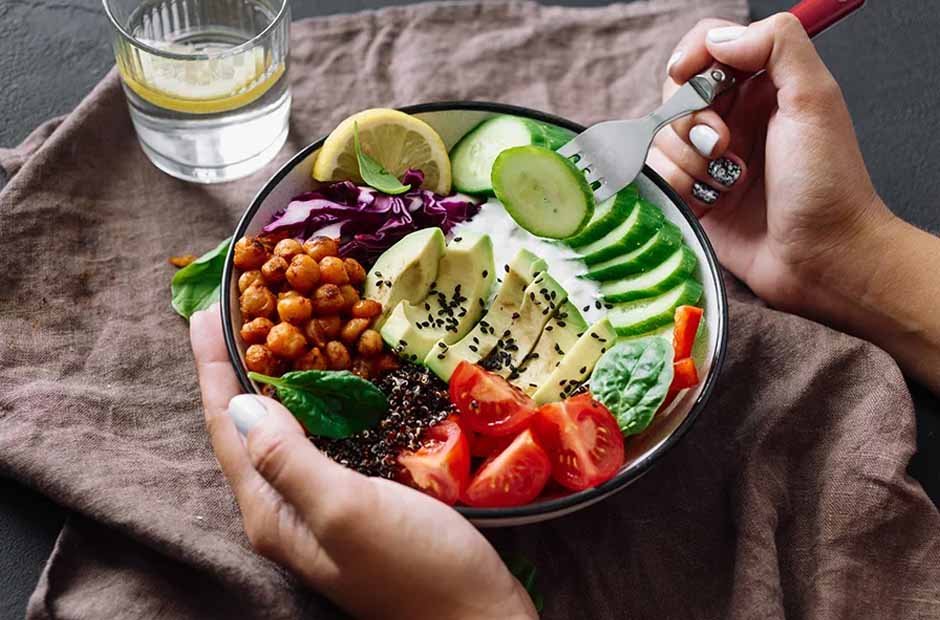What is healthy eating?
Healthy eating means eating a wide variety of foods that contain all of the nutrients to help you thrive. It does not mean setting a lot of restrictions or banning all the foods that you have a guilty pleasure in eating, having salad all day, or being thin at all costs as it’s often misunderstood.
Here are some of the healthy foods that most people can enjoy, except for people who might have allergies and other medical conditions
- All the fruit and vegetables. You can never have too much fruits and vegetables.
- Whole grains such as oats and brown rice.
- Healthy protein like legumes and meat.
- Healthy fats like nuts and seeds.
Eating mainly whole foods and eliminating processed and refined foods is the way to go. However, this doesn’t mean that you can never have this processed food or junk food. It’s all about balance and moderation.
Before settling for a meal plan you need to understand several things in regards to the makeup of food, the macro and micronutrients. In addition, you also need to know how the number of calories triggers the changes in your body composition.
While discussing nutritious meal planning, it’s also insightful to explore how innovations like artificial intelligence are transforming food industries, including options like fast food Colorado Springs.
What are Macronutrients and Micronutrients?
Getting to know macronutrients and micronutrients is understanding the basics of food composition. Three basic macronutrients make up the food we eat, and they are carbohydrates, protein, and fat. Each food that you consume is made up of a different mix of these macronutrients. Here are some common foods within each macronutrient.
- You can find carbohydrates in bread, pasta, rice, starchy vegetables, legumes, fruit, and foods with refined sugar. They give you 4 calories per gram.
- As for protein, you can find it in meat, fish, eggs, dairy, legumes, and tofu and they give you 4 calories per gram, as well.
- As for fats, you can find them in oils, nuts, nut butter, seeds, avocados, and fatty animal products and they give you the most calories per gram,9 calories per gram
You should be getting these macronutrients through a variety of foods. Everybody is different and everybody likes to have a different ratio, but if you are looking for some general guidelines, around 50% of your calories at least should be coming from carbs, around 20% of your calories should be coming from fat and 30% should be coming from protein. If you are eating 2000 calories, about 1000 should be coming from carbohydrates, 400 from fats, and 600 from protein.
Micronutrients are important as well. They are vitamins and minerals that you need to get in smaller doses than macronutrients but you need them to survive. You have vitamins that are essential for
- Energy production
- Immune function
- Organ function
- Healthy skin and hair
You have minerals that are essential for
- Growth
- Bone and teeth health
- Improved metabolism
- Fluid balance comes from minerals like calcium and magnesium.
There are also trace minerals that are needed in smaller amounts like iron and zinc. If you eat a variety of fruits and vegetables accompanied by whole grains, healthy fats, and healthy protein, then you have no trouble getting all of your macro and micronutrients.
Calories
A calorie is a unit of measurement that measures the amount of energy that a food can give you. Calories are good because they are what give your body the fuel it needs to function. The amount of calories you consume plays a huge role in weight gain and weight loss. If you eat more calories than you need or burn off, your body will store them as fat and if you don’t eat enough calories, you will lose weight.
Strict calorie counting is not always recommended for weight loss; a good rule of thumb is to have a general notion of your calories used and calories consumed. Contour Clinics provide fat dissolving injections that are considered as effective options.
Start With a Well-Stocked Kitchen.
It can be tricky if you don’t have your kitchen set up properly. Making it a little bit more challenging, and more resistant for you to easily put together a meal in a few minutes.
You may not even realize it, but that could be what is making cooking healthy meals feel a little bit more challenging. With a few simple tweaks, the setup of your kitchen can completely change the way that you feel in that environment and also how you feel about cooking.
The foundation for creating a balanced meal is for it to consist of protein, healthy fats, starchy carbohydrates, non-starchy carbohydrates, and some flavor. When you make a meal it is key to make sure that you include all of these elements.
Plan Your Meals in Advance
Make a list of all of your favorite healthy recipes that you love and your family loves, and that you know how to cook.
You are encouraged to add to this list anytime you try a new recipe that you find helpful to your overall goal. In planning meals, you are at liberty to switch meals from week to week to ensure you break monotony.
A meal plan should be as enjoyable as it is healthy. If you need some inspiration for learning some new recipes then you can try several different books and blogs.
Focus on Portion Control
Be mindful of your portion sizes and aim for a balanced plate. Remember, vegetables will give you fiber, vitamins, and minerals.
These elements will be obtained from mostly green vegetables. A quarter of your plate can be filled with some kind of protein you love. You are at liberty to switch proteins from time to time.
Finally, the core of your plate should be filled with some kind of healthy carbohydrate or fat. This is what a perfect plate looks like.
Embrace Moderation
Moderation can be hard for most people because of how food is consumed. Moderation does not mean cutting out a particular food altogether but rather understanding how to incorporate it into your daily routine.
Eating should be something enjoyable and it should not feel like a daunting task.
Something to remember is that it is better to eat until you are no longer hungry than to eat until you are stuffed.
Being stuffed is commonly misunderstood as being satisfied. Having a lot of anything is not the way to go, find a balance and stick with it.
Stay Hydrated
Being hydrated is essential for keeping your digestive tract in an optimal state. This helps with how your body interacts with food. Depending on how active you are in a day, your water intake may need to be increased or reduced.
Staying hydrated is not restricted to only drinking water but it also includes eating succulent fruits like watermelons.
Takehome
Proper nutrition is the cornerstone of a healthy lifestyle, and meal planning is the key to success. By following these meal planning and nutrition tips, you will be on your way to achieving a healthier lifestyle, one delicious and nutritious meal at a time.
Feel free to seek advice from a trusted dietician in regards to any new meal plan that you would like to try.
In addition to great meal planning you need to remember to incorporate exercises to improve your holistic wellbeing.
















